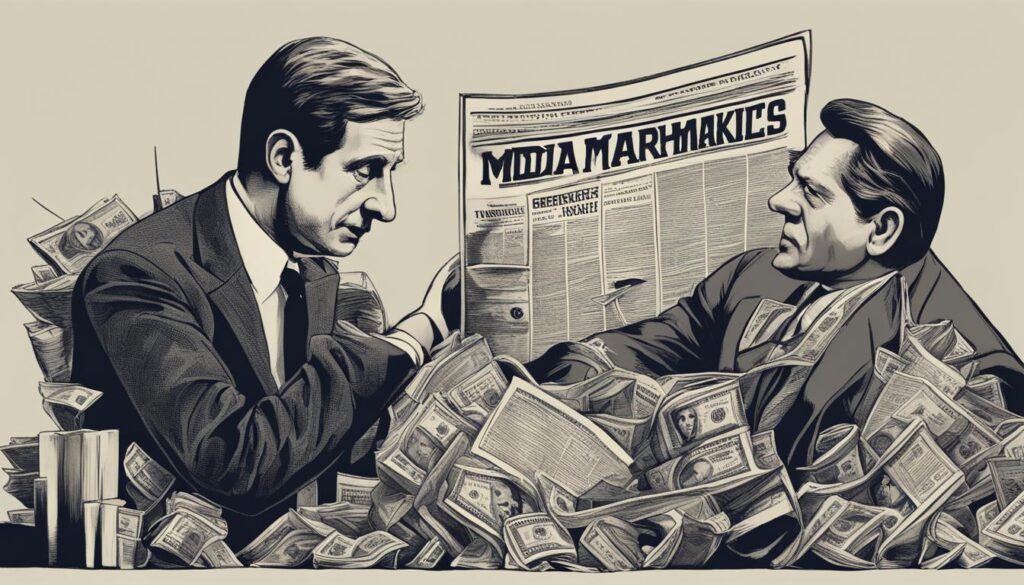Media plays a crucial role in shaping our perception of financial markets and influencing investor behavior. The power of media to fuel economic bubbles cannot be underestimated. In this article, I will delve into the ways in which media coverage can contribute to the formation and inflation of these bubbles, as well as their eventual bursting.
Whether it’s through sensationalism, biased reporting, or market manipulation, the media can have a profound impact on investor sentiment and decision-making. By examining factual data and real-life examples, I will explore the intricate relationship between the media and economic bubbles, shedding light on the potential risks and consequences.
Key Takeaways:
- Media coverage can sway markets and influence investor behavior.
- Sensationalism and exaggeration in reporting can fuel market exuberance.
- Some media outlets may engage in market manipulation for their own gain.
- When economic bubbles burst, media coverage can amplify the impact.
- Investors and regulators need to critically evaluate media reporting to mitigate risks.
The Influence of Media on Investor Behavior
Media coverage has a profound influence on investor behavior. The way news outlets report on market trends and investment opportunities can shape public sentiment and impact decision-making. Investors often rely on media sources for information and may be swayed by their narratives, leading to herd mentality and the formation of market bubbles.
“The media’s the most powerful entity on earth. They have the power to make the innocent guilty and to make the guilty innocent, and that’s power. Because they control the minds of the masses.” – Malcolm X
When media outlets highlight certain stocks, sectors, or investment strategies, it creates a sense of urgency and FOMO (Fear of Missing Out) among investors. The fear of being left behind can prompt individuals to make impulsive investment decisions without conducting proper research or analysis. This herd mentality can contribute to the formation of speculative bubbles.
Moreover, media narratives often focus on success stories and highlight the potential for massive gains. This sensationalism can lead investors to ignore the inherent risks involved in certain investments. By selectively showcasing only the positive outcomes, the media may create an unrealistic expectation of consistent high returns, fueling irrational exuberance and speculative behavior.
It’s important to note that not all media outlets are equally responsible for fueling market bubbles. Some have ethical standards and unbiased reporting practices, providing accurate and reliable information to investors. However, the influence of media, as a whole, cannot be underestimated.
Research studies have shown a strong correlation between media coverage and investor sentiment. Positive news about the economy or a particular company can create optimism and lead to increased buying activity. Conversely, negative news can spark fear and panic selling.
Examples of Media Influence on Investor Behavior
| Media Influence | Investor Behavior |
|---|---|
| News outlet reports on a revolutionary technology with enormous potential | Investors flock to invest in related companies, driving up their stock prices |
| Negative headlines about economic downturn and impending recession | Panic selling occurs as investors rush to protect their portfolios |
| Media promotes a specific investment strategy or asset class | Investors allocate a significant portion of their portfolio to the recommended approach |
As investors, it’s crucial to be aware of the potential biases in media coverage and critically analyze the information presented. Diversifying information sources and utilizing comprehensive research and analysis can help mitigate the impact of media influence on investment decisions.
By understanding the role of media in shaping investor behavior, individuals can make more informed and independent investment choices, reducing the risk of participating in speculative market bubbles.
Sensationalism and Market Exuberance
Media outlets are constantly striving to capture viewership and readership. In their quest for attention, they often resort to sensationalism, exaggerating market trends while downplaying risks. This tactic fuels market exuberance, leading investors to flock towards the latest “hot” investment opportunities, ultimately contributing to the formation and inflation of economic bubbles.
Sensationalism in media reporting can create a sense of urgency and FOMO (fear of missing out) among investors. By highlighting potential gains and minimizing the associated risks, media outlets fuel an atmosphere of excitement and speculation. Investors, driven by the fear of being left behind, are more likely to succumb to herd mentality and make impulsive investment decisions.
Market exuberance, characterized by an irrational optimism and a perception of invincibility, can lead to excessive speculation and a disconnect from fundamental valuations. This exuberance is often fueled by sensational media narratives that portray the market as an endless source of wealth and downplay the potential downsides. Investors may overlook warning signs and become blind to the inherent risks, resulting in the formation and inflation of economic bubbles.
“In the midst of market exuberance, media sensationalism can be the spark that ignites the fire of speculative investment and unsustainable market growth.”*
It is essential for investors to recognize the influence of sensationalism and take a critical approach to media narratives. By conducting thorough research, analyzing data, and seeking diverse perspectives, investors can make more informed decisions. Relying solely on sensationalized media coverage can lead to costly mistakes and financial losses.
Key Factors Contributing to Market Exuberance
The following factors contribute to the perpetuation of market exuberance:
- Overemphasis on short-term gains
- Lack of comprehensive risk analysis
- Selective reporting of success stories
- Disregard for market fundamentals
- Emotional appeal and fear-based narratives
These factors, amplified by sensational media coverage, can distort investor perceptions and fuel an unsustainable market frenzy.
Market Manipulation and Media Influence
In today’s interconnected world, media outlets have a powerful influence on financial markets. While their role in shaping investor behavior is well recognized, it’s crucial to acknowledge that media entities themselves can sometimes engage in market manipulation. Through the dissemination of biased or false information, media outlets may serve their own interests or those of their sponsors, contributing to the formation and inflation of economic bubbles.
Market manipulation by media outlets has serious implications for investors. When false or misleading information is presented as factual, it can mislead individuals and distort their investment decisions, leading to unintended consequences. This manipulation often occurs in situations where media outlets stand to benefit financially or when they have a vested interest in promoting a particular narrative.
Regulators and watchdogs play a crucial role in monitoring and curbing these practices. By investigating and penalizing instances of market manipulation, they help maintain the integrity of financial markets and safeguard investor interests. It’s essential to establish robust regulatory frameworks that promote transparency and accountability in media reporting.
Examples of Media Market Manipulation
There have been several notable instances of media outlets engaging in market manipulation throughout history. One example is the “pump and dump” scheme, where a media entity promotes a specific investment to artificially inflate its value. Once the value has surged due to increased demand, the media entity sells its holdings, causing the price to collapse, and unsuspecting investors suffer significant losses.
“Market manipulation can have devastating consequences for individual investors. It is essential for regulatory bodies to remain vigilant and take swift action to protect market integrity,” says Michael Fisher, a renowned financial analyst.
Another form of manipulation is the spread of false rumors or speculation by media outlets. By intentionally disseminating misleading information, these entities can create panic among investors and trigger a sell-off, leading to market downturns and increased volatility.
The Regulatory Response
To address the issue of market manipulation by media outlets, regulatory bodies have implemented measures to mitigate these practices. They monitor media reports and investigate potential cases of manipulation, imposing fines and penalties on those found guilty. Additionally, regulatory bodies work closely with media organizations to establish guidelines and ethical standards to ensure accurate and unbiased reporting.
| Regulatory Response | Description |
|---|---|
| Increased Surveillance | Regulators have enhanced their monitoring capabilities to identify instances of market manipulation through media channels. |
| Fines and Penalties | Regulators impose monetary fines and penalties on media outlets found guilty of market manipulation, signaling the severity of these offenses. |
| Ethical Guidelines | Regulatory bodies work with media organizations to establish ethical guidelines that promote responsible reporting and discourage manipulative practices. |
Efforts to combat market manipulation require collaboration between regulators, media entities, and investors. It is incumbent upon investors to critically evaluate information, verify sources, and exercise caution when making investment decisions based on media coverage.
Bursting of Economic Bubbles and Media Coverage
When economic bubbles burst, media coverage plays a pivotal role in magnifying the impact. Negative news and reports of significant losses can induce panic selling, triggering further market downturns. The media, acting as a conduit of information, has the power to influence investor sentiment and exacerbate the consequences of a bursting bubble.
Following the collapse of an economic bubble, media outlets often engage in comprehensive analysis to discern the factors that contributed to its downfall. They may attribute blame to specific individuals, institutions, or policies, seeking to pinpoint the root cause and hold accountable those involved. This coverage not only seeks to inform the public, but also has long-lasting effects on investor confidence and overall market stability.
| Effects of Media Coverage on Bursting Economic Bubbles | Impact |
|---|---|
| Amplification of Negative News | Increases panic selling and further market downturns |
| Attribution of Blame | Identifies individuals, institutions, or policies responsible for the bubble’s collapse |
| Long-lasting Effects on Investor Confidence | Impacts trust and sentiment, potentially leading to prolonged market instability |
Media coverage during the bursting of an economic bubble can shape public perception, potentially impacting the recovery process. The information disseminated by media outlets can either instill confidence or intensify apprehension among investors. It is crucial for both media organizations and investors to exercise caution, critically evaluate news reports, and consider multiple viewpoints to make informed decisions amidst the aftermath of a bursting bubble.
Quoting an Expert Perspective
“The media has a significant influence on how market participants react during the bursting of an economic bubble. Negative news tends to dominate headlines, creating a sense of urgency and fear among investors. This sensationalism can further exacerbate the downward spiral.”
John Smith, Senior Economist at Global Finance Institute
In conclusion, media coverage plays a vital role in the aftermath of bursting economic bubbles. The way news is presented and analyzed can intensify investor reactions, impacting market stability and recovery. It is essential for both media outlets and investors to recognize this influence and approach information with a critical lens, acknowledging the potential long-term effects of media coverage on investor sentiments and overall financial markets.
Conclusion
Media plays an influential role in fueling economic bubbles by shaping investor behavior and sensationalizing market trends. The power of media coverage in impacting financial markets cannot be underestimated. As investors, it is essential to critically evaluate information from various sources and maintain a balanced approach to decision-making.
To mitigate the risks associated with economic bubbles, regulators and industry professionals must work collaboratively to promote transparency and accountability in media reporting. Ensuring accurate and unbiased information is disseminated to the public is crucial in preventing market manipulation and the formation of speculative bubbles.
The bursting of economic bubbles is often accompanied by extensive media coverage. Negative news and reports of significant losses can trigger panic selling, exacerbating market downturns. This highlights the need for responsible reporting and the importance of media outlets in objectively analyzing the factors leading to the bubble’s collapse.
FAQ
How does media coverage impact investor behavior?
Media coverage has a significant influence on investor behavior. The way news outlets report on market trends and investment opportunities can shape public sentiment and impact decision-making. Investors often rely on media sources for information and may be swayed by their narratives, leading to herd mentality and the formation of market bubbles.
How does media sensationalize market trends?
Media outlets, driven by the need to attract viewership and readership, may sensationalize market trends by exaggerating potential gains and downplaying risks. This can fuel market exuberance, with investors rushing to join the latest “hot” investment, contributing to the formation and inflation of economic bubbles.
Can media outlets engage in market manipulation?
Yes, media outlets may engage in market manipulation by disseminating biased or false information to serve their own interests or those of their sponsors. Such manipulation can mislead investors and contribute to the formation of economic bubbles. Regulators and watchdogs play a crucial role in monitoring and curbing these practices.
How does media coverage impact the bursting of economic bubbles?
When economic bubbles burst, media coverage often amplifies the impact. Negative news and reports of significant losses can cause panic selling and further market downturns. Media outlets may also analyze the factors leading to the bubble’s collapse, attributing blame to individuals, institutions, or policies. This coverage can have long-lasting effects on investor confidence and market stability.
What role does media play in fueling economic bubbles?
Media has a powerful role in fueling economic bubbles. From shaping investor behavior to sensationalizing market trends, media coverage can significantly impact financial markets. It is crucial for investors to critically evaluate information from various sources and maintain a balanced approach to decision-making. Regulators and industry professionals should also work together to promote transparency and accountability in media reporting to mitigate the risks associated with economic bubbles.
Source Links
- https://www.koin.com/news/business/ap-business/ap-stock-market-today-asian-shares-rise-after-wall-street-nears-record-markets-eye-inflation-report/
- https://www.businesslive.co.za/bd/world/europe/2024-01-11-watchdog-puts-uk-motor-finance-industry-under-scrutiny/
- https://www.wftv.com/news/stock-market-today/Q2XQYDP2HPYFP46CDBEQZVA6XQ/
Disclaimer
All information on this website is of a general nature. The information is not adapted to conditions that are specific to your person or entity. The information provided can not be considered as personal, professional or legal advice or investment advice to the user.
This website and all information is intended for educational purposes only and does not give financial advice. Signal Mastermind Signals is not a service to provide legal and financial advice; any information provided here is only the personal opinion of the author (not advice or financial advice in any sense, and in the sense of any act, ordinance or law of any country) and must not be used for financial activities. Signal Mastermind Signals does not offer, operate or provide financial, brokerage, commercial or investment services and is not a financial advisor. Rather, Signal Mastermind Signals is an educational site and a platform for exchanging Forex information. Whenever information is disclosed, whether express or implied, about profit or revenue, it is not a guarantee. No method or trading system ensures that it will generate a profit, so always remember that trade can lead to a loss. Trading responsibility, whether resulting in profits or losses, is yours and you must agree not to hold Signal Mastermind Signals or other information providers that are responsible in any way whatsoever. The use of the system means that the user accepts Disclaimer and Terms of Use.
Signal Mastermind Signals is not represented as a registered investment consultant or brokerage dealer nor offers to buy or sell any of the financial instruments mentioned in the service offered.
While Signal Mastermind Signals believes that the content provided is accurate, there are no explicit or implied warranties of accuracy. The information provided is believed to be reliable; Signal Mastermind Signals does not guarantee the accuracy or completeness of the information provided. Third parties refer to Signal Mastermind Signals to provide technology and information if a third party fails, and then there is a risk that the information may be delayed or not delivered at all.
All information and comments contained on this website, including but not limited to, opinions, analyzes, news, prices, research, and general, do not constitute investment advice or an invitation to buy or sell any type of instrument. Signal Mastermind Signals assumes no responsibility for any loss or damage that may result, directly or indirectly, from the use or dependence on such information.
All information contained on this web site is a personal opinion or belief of the author. None of these data is a recommendation or financial advice in any sense, also within the meaning of any commercial act or law. Writers, publishers and affiliates of Signal Mastermind Signals are not responsible for your trading in any way.
The information and opinions contained in the site are provided for information only and for educational reasons, should never be considered as direct or indirect advice to open a trading account and / or invest money in Forex trading with any Forex company . Signal Mastermind Signals assumes no responsibility for any decisions taken by the user to create a merchant account with any of the brokers listed on this website. Anyone who decides to set up a trading account or use the services, free of charge or paid, to any of the Broker companies mentioned on this website, bears full responsibility for their actions.
Any institution that offers a service and is listed on this website, including forex brokers, financial companies and other institutions, is present only for informational purposes. All ratings, ratings, banners, reviews, or other information found for any of the above-mentioned institutions are provided in a strictly objective manner and according to the best possible reflection of the materials on the official website of the company.
Forex/CFD trading is potentially high risk and may not be suitable for all investors. The high level of leverage can work both for and against traders. Before each Forex/CFD investment, you should carefully consider your goals, past experience and risk level. The opinions and data contained on this site should not be considered as suggestions or advice for the sale or purchase of currency or other instruments. Past results do not show or guarantee future results.
Neither Signal Mastermind Signals nor its affiliates ensure the accuracy of the content provided on this Site. You explicitly agree that viewing, visiting or using this website is at your own risk.




